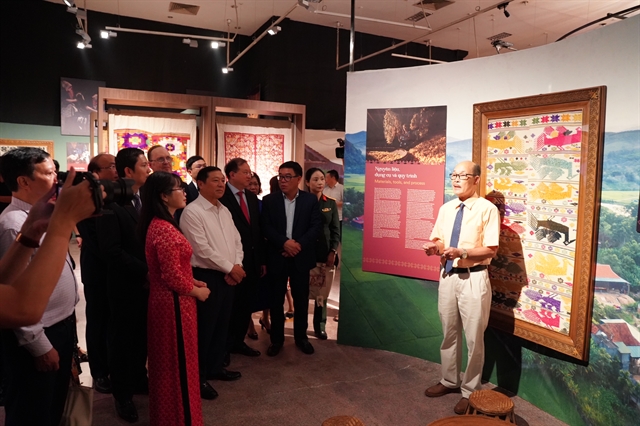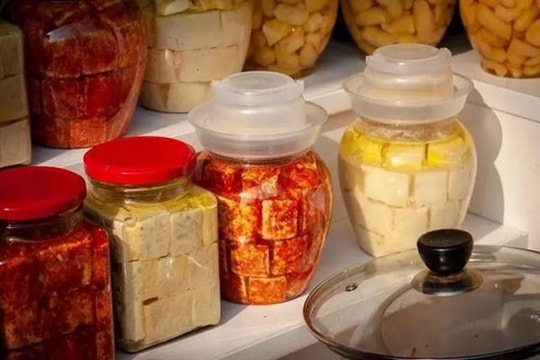 |
| Delegates cut the ribbon to open the quilts exhibition at the Vietnam Museum of Ethnology on October 18. — VNS Photo Thanh Hải |
HÀ NỘI — A collection of 190 textile quilts (nà pha) some nearly a century old are on show at the Vietnam Museum of Ethnology until January 17 next year.
The exhibition, The Art of Decorative Patterns of the Tai in Nghệ An, was jointly organised by the Vietnam Museum of Ethnology and Trúc Lâm Handmade One Member Company.
Trúc Lâm Company collected the precious artifacts in the 1990s from the White Tai (Tày Mường group) in the west of Nghệ An Province.
 |
| Former head of the Collection Research Department of Vietnam Museum of Ethnology Vi Văn An explains about meanings of quilt's decorative patterns. — VNS Photo Thanh Hải |
With an average width of about 40 centimetres, nà pha are woven using khuýt (supplementary weft) or xéo (embroidery) techniques with dyed silk threads, then sewn onto a cotton fabric base. The decorative patterns primarily follow a realistic style, depicting four main themes: animals, plants, objects and natural phenomena.
Through exquisite weaving and embroidery techniques, combined with harmonious colour coordination, nà pha showcases the distinct characteristics of textile products from the Tai of Nghệ An and specifically the Tày Mường group.
With an age ranging from 35 to 95 years, this collection is considered one of the rare remaining textile heritage pieces. Not only does it reflect the worldview and philosophy of the Tai people, but it also holds historical and cultural value, particularly showcasing the aesthetic sensibilities of the Tai through the expression of unique and intricate colours and patterns.
 |
| Most quilts feature a combination of multiple patterns, some of which must be executed using embroidery techniques. — VNS Photo Thanh Hải |
Deputy Director in charge of the Vietnam Museum of Ethnology Bùi Ngọc Quang said that the collection was evaluated by heritage experts and ethnologists as a rare heritage with profound cultural and historical value.
“These 190 artifacts were selected among thousands of works collected by Trúc Lâm Company since the 90s of the last century in the White Tai area in Nghệ An's western region. This collection shows that Trúc Lâm not only produces and sells handmade items but also pays great attention to researching, collecting, storing and preserving the nation's cultural heritage," said Quang.
Nà pha is used as a blanket cover, a dowry for the bride as a gift when returning to her husband's house, a robe to keep children warm in the winter and as a decoration for Tết (Lunar New Year). Through sophisticated weaving and embroidery techniques and harmonious colour combinations with natural materials, nà pha represents the aesthetic characteristics of textile products of the Tai in Nghệ An.
Former head of the Collection Research Department of Vietnam Museum of Ethnology Vi Văn An, a Tai person in Nghệ An said: “When talking about Tai people, we have to talk about weaving, a profession that Tai people in Nghệ An have owned for a long time. Weaving comes into the lives of Tai people from food, clothing, housing, religious rituals and beliefs.”
Most quilts feature a combination of multiple patterns, some of which must be executed using embroidery techniques. Embroidery technique particularly excels on skirts, where the realistic, sharp and vibrant patterns enhance the artistic and aesthetic value of the products.
 |
| Nà pha is used as a blanket cover, a dowry for the bride as a gift when returning to her husband's house, a robe to keep children warm in the winter and as a decoration for Tết (Lunar New Year). — VNS Photo Thanh Hải |
Animal motifs are quite common on quilts and skirts in Tai culture, depicting both terrestrial and aquatic animals. Among the land animals, the most popular are images of deer, elephants, horses, peacocks, butterflies, chickens and dragons.
Each motif carries a symbolic meaning. For example, the dragon symbolises strength, the elephant represents loyalty, the deer, peacock and butterfly symbolises beauty and the horse signifies freedom.
Deputy Director of Trúc Lâm Handmade Company Vũ Thị Liên said: “Starting in the 1990s, we have devoted a lot of effort to collecting, preserving and maintaining this collection.
"Each quilt, each pattern, tells a story about the culture, life and soul of the Tai people. We believe that through this exhibition, the public will have the opportunity to feel the delicate beauty in each pattern on each nà pha, and from there, appreciate the cultural values of the nation more.”— VNS























